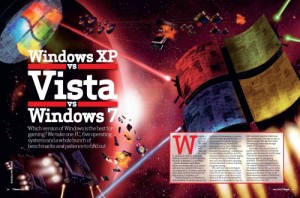Windows 7 review: The Clash of Three Windows (3)
 To the fence sitters out there, to those who are still clinging to their copies of Windows XP, read on. There is one good reason why Windows 7 should be in your radar screen – performance. The latest version of Windows, due for release October this year, promises improved performance and usability over Windows Vista, but is this enough to convince Windows XP users to make the switch?
To the fence sitters out there, to those who are still clinging to their copies of Windows XP, read on. There is one good reason why Windows 7 should be in your radar screen – performance. The latest version of Windows, due for release October this year, promises improved performance and usability over Windows Vista, but is this enough to convince Windows XP users to make the switch?
To find out, three generations of Microsoft’s operating system were tested side by side on three identical PCs – Windows XP upgraded to service pack 3, Windows Vista 64 Service Pack 2 and the 64 bit edition of Windows 7. Early on in the tests, it was obvious that with Windows 7, the hard disk indicator light did not blink as much as it did when running Vista.
Different applications were used in order to benchmark how modern computers utilize critical hardware components:
- Main Concept and ProShow was used for measuring multi threaded CPU performance,
- PC Mark Vantage for finding out hard drive performance, and
- Photoshop for benchmarking a real world combination of both CPU performance and hard disk throughput.
In most of these tests, the performance of Windows 7 was almost similar to Windows XP. However, credit should be given to Microsoft’s Service Pack 2 for Vista for fixing some of Windows Vista’s performance problems head on such that in some of the tests, Vista SP2 fared equally well with Windows 7.
Lackluster network performance was so obvious in early versions of Windows Vista such that it was very important and highly anticipated to find out if Windows 7 suffered the same malaise. Microsoft kicked this problem so hard – transferring files across the network was unbelievably fast. Gone is the wait for the hourglass cursor to disappear.
A big segment of Windows XP users are hardcore gamers who rightfully believe that Windows Vista is just a big drag in a world where speed reigns supreme. To find out if there is a cause for concern for would be converts to Windows 7, the test computer was rigged with ATI and alternated by Nvidia graphics cards. Graphics performance was determined using DirectX 9 and 10 benchmarks.
Test scores for DirectX 10 on computers running Vista and Windows 7 were virtually similar for both cards. This was kind of expected because the same drivers are used for both graphics card on both Windows versions. The scores were different though for tests benchmarking DirectX 9 graphics performance for both cards. Windows 7 could be ten percent slower on one test but also ten percent faster in another. Overall, the performance scores for DirectX 9 graphics for Vista and Windows 7 ended the same.
Windows XP can never run DirectX 10 and 11 based graphical applications in full capacity. This is the one reason why it could be worthwhile making the switch from XP to Windows 7. Windows 7 utilizes the Windows Display Driver Model which, sadly for Windows XP users, is a requirement to run DirectX10 and 11 apps in full mode. This reason plus Nvidia’s and ATI’s commitment on improving graphical performance for the latest edition of Windows only speaks well for enhanced gaming experience under Windows 7.